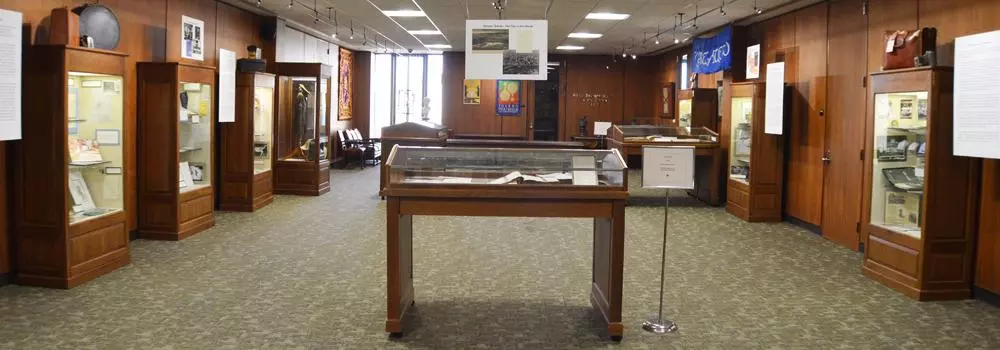By the Ward M. Canaday Center for Special Collections
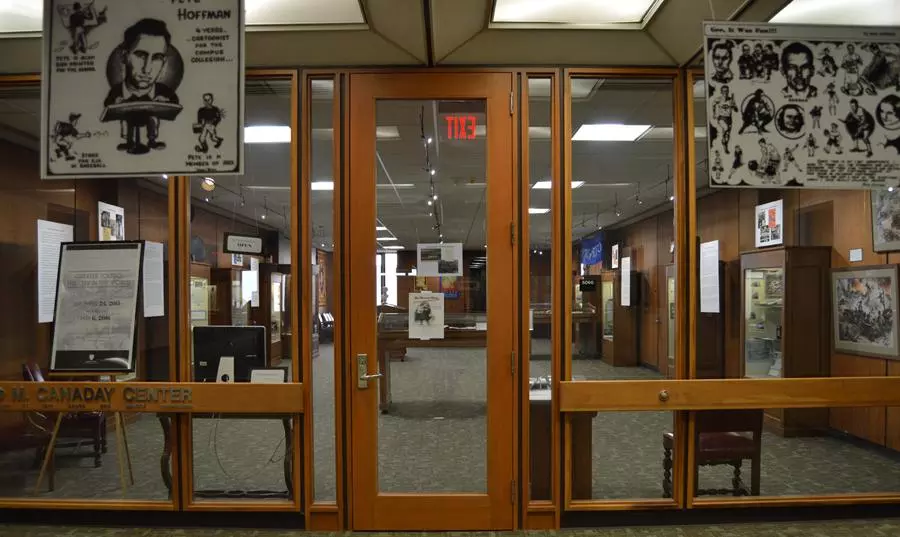 Ward M. Canaday Center for Special Collections
Ward M. Canaday Center for Special Collections
Introduction (Summary)
By choosing the name “Toledo,” the founders of the city in 1837 seemed interested in promoting it as a place with an international focus. It is uncertain why “Toledo” was selected as the name for the new entity. At the time, all things Spanish were in vogue, and the name may have been a way to not only honor Toledo, Spain, but also as a way to portray the new Toledo as fashionable, trendy, and perhaps exotic.
It was not only its name that seemed to predict the city’s global focus. In 1868 one of its early land investors, Jesup W. Scott, published a pamphlet promoting Toledo titled “A Presentation of Causes Tending to Fix the Position of the Future Great City of the World in the Central Plain of North America.” In the pamphlet, Scott laid out his theory that since ancient times, the world’s economic center had been moving westward, and it would only be a matter of time before the next great commercial center would be located in the interior of the United States. It is perhaps not surprising that someone who owned a great deal of real estate in Toledo would promote the city as that Future Great City of the World.
The dream of Toledo as the world’s future great city would influence generations. Every new industry, every new development, all were evidence of the greatness of Toledo and its future as a center of world commerce. It even influenced Jesup Scott to endow a university to provide educational opportunities to the young people of Toledo, who would help to establish the Future Great City. And while Toledo would never become the world’s greatest city, it did, through its largest industry, establish itself as the Glass Capital of the World.
This exhibit looks at both the influence of Toledo on the world and the influence of the world on Toledo. It examines individuals from Toledo who traveled to far-flung places and brought back ideas that shaped their future and that of the city. It also looks at how people from Toledo changed the world, the ways in which soldiers from the city were affected by their international military service, how immigration of people from foreign lands impacted the city’s ethnic diversity, and finally, how Toledo businesses and industries expanded to become global corporations.
This exhibit is an historical one, but it is important to remember that globalization is an ongoing movement that has been hastened in recent decades by technology. Globalization has had both a positive and negative impact on Toledo. While the world seems ever closer, its closeness brings uncertainty. It is hoped that this exhibit will remind us that Toledo’s interactions with the world have been mutually beneficial and that embracing globalization will continue to provide opportunities for exchange that will improve the city and the world.
Exhibition catalog and video
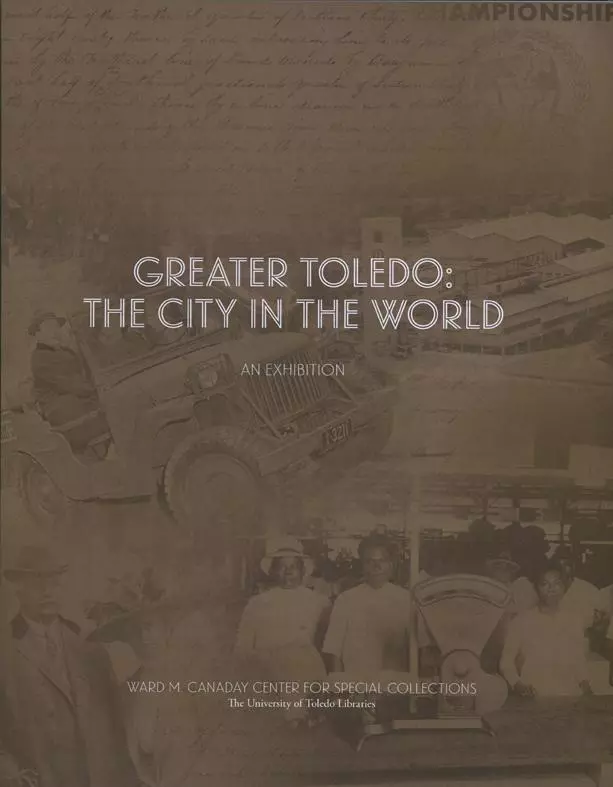 Greater Toledo: City in the World (Exhibition Catalog)
Greater Toledo: City in the World (Exhibition Catalog)
This three-minute video summarizes the history behind Toledo and its global connections. Narrated & Produced by Richard Kruzel, Audio-Visual Specialist at the Ward M. Canaday Center for Special Collections. Network speed, equipment capability, and server traffic may affect the time needed to view this video.
The "Greater Toledo: The City in the World" exhibition was open to the public at the University of Toledo's Ward M. Canaday Center for Special Collections from September 24, 2015 through May 6, 2016. It explored Toledo's global connections through intellectual, cultural, commercial, political, and military themes. The aim behind the virtual exhibition was to emulate the physical experience to a reasonable extent while enhancing that with easy access to resources in order to foster research, teaching, and public conversation.
Exhibits (Case Views)
Exhibits by Theme
Visual Tours: Case-by-case (exhibit case views)
The layout of this virtual exhibition closely follows the narrative in the Exhibition Catalog. Starting with the front center and continuing in a clockwise direction, the cases contain exhibits and descriptive information. Follow the links and linkable images in this virtual exhibition, and explore the related digital resources, professionally preserved archives and manuscript collections, and other resources of the University of Toledo Libraries.
Introduction
By choosing the name “Toledo,” the founders of the city in 1837 seemed interested in promoting it as a place with an international focus. At the time, all things Spanish were in vogue, and the name may have been a way to make the new Toledo seem fashionable, trendy, and perhaps exotic. [read the complete summary]
Chapter 1 - Toledo In the World
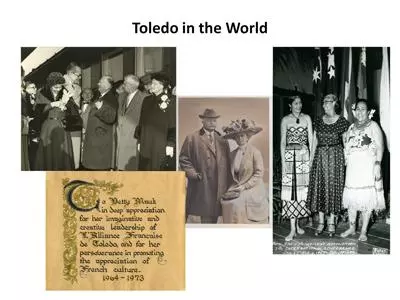 CHAPTER 1 - Toledo In the World
CHAPTER 1 - Toledo In the World
Toledo has experienced an influx of international influences from residents who traveled abroad, embraced the cultures they experienced, and brought back with them global ideas. These international influences of Toledo residents have shaped the city in many rich and significant ways.
Edward Drummond Libbey and his wife, Florence Scott Libbey, are the best example of how travel abroad has improved the lives of all citizens of our city. In 1888, Libbey moved to Toledo from Massachusetts and established the Libbey Glass Company. From this one company, three others followed, making Toledo the Glass Capital of the World. Libbey used much of his vast fortune to found the Toledo Museum of Art in 1901. He and his wife began to travel the world purchasing art for the infant museum—so much so that in 1912 a new museum was built to house the expanding collection. Today, the Toledo Museum of Art has an international reputation, and Toledoans have a chance to appreciate art from everywhere in the world.
There are plenty of other examples of how the world shaped citizens of our city. Adam Grant used creative expression to help him survive years in German concentration camps, and after relocating to Toledo, produced beautiful works of art that inspired. Betty Mauk was influenced by frequent trips to France to try to develop Toledo’s riverfront like that of Paris. Today, we appreciate her effort to create Promenade Park. Ella P. Stewart took the ideas of peace and social justice from her life as an African-American, and spread those ideas to Southeast Asia and the Pacific. Ward and Mariam Canaday invested much of their fortune in restoring antiquities in Athens, Greece. But through their generosity, they befriended the King and Queen of that country, and hosted a visit by the royal couple in 1953 that allowed the city to show itself off to the world.
Chapter 2 - Toledo Changes the World
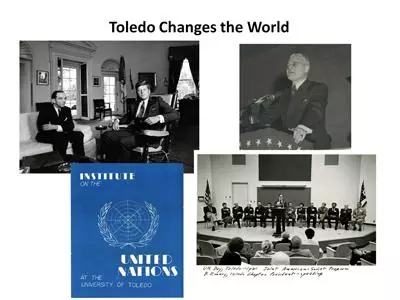 Chapter 2 - Toledo Changes the World
Chapter 2 - Toledo Changes the World
Toledo’s global connections are about more than how the world impacted the city. Toledoans have also impacted the world through their personal actions and organizations they helped to create. Many of these efforts have focused on promoting peace and global understanding. While isolationism has historically been the predominate world view of Midwesterners, Toledo is perhaps unique in the way its citizens have viewed their responsibilities to the global community.
Gustavus Ohlinger, a Toledo lawyer, is one example. Born in China, he represented the Russian government in negotiations that ended the Russo-Japanese War in 1905. Brand Whitlock, a Toledo mayor, was appointed minister to Belgium in 1913, and when World War I broke out, he helped to save that country from starvation by overseeing the relief effort. Foy Kohler, ambassador to the Soviet Union during the Kennedy administration, not only helped to keep the Cold War from heating up, but also showed the Russians how democracy worked during the peaceful transfer of power following Kennedy’s assassination.
Leaders of the University of Toledo also influenced the world. Philip Nash, who worked his entire life to promote world peace, was a consultant to the conference that drafted the charter of the United Nations. William S. Carlson influenced the world through his research on Greenland, which he surveyed and helped to establish air bases there that became pivotal lifelines for pilots during World War II.
Toledoans also helped to promote global understanding through sports. In 1962, Joseph Scalzo brought athletes from 28 countries to the city for the Amateur World’s Wrestling Championships. The event was one of the first where athletes from Soviet Bloc countries were allowed to travel abroad to compete. And it focused the world’s attention on Toledo.
Chapter 3 - Toledoans in Foreign Wars
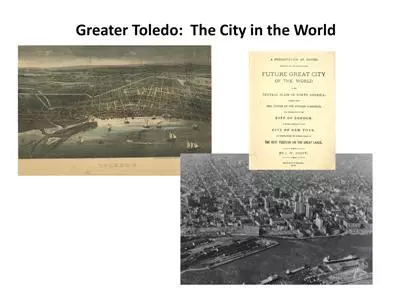 Chapter 3 - Toledoans in Foreign Wars
Chapter 3 - Toledoans in Foreign Wars
Foreign wars have impacted the lives of many Toledoans. Most studies of U.S. Involvement in wars abroad have concentrated on the causes and politics surrounding wars. It is easy to forget the impact of war on individuals soldiers. The firsthand accounts of soldiers from the Toledo area recorded in their journals, letters home, and keepsakes provide documentation of how these wars changed their lives, and impacted those at home.
Being overseas allowed Toledo soldiers to experience new places and cultures, and created opportunities that would have been impossible otherwise. Herbert White would sneak off from his battalion to experience French culture during his service in World War I. William Barlowe, who served in the Pacific theatre during World War II, had a more cynical view of his surroundings: “Nothing but jungle here,” he wrote. Dr. Max Schnitker, a Toledo neurosurgeon, used his war experience to further his professionals skills, operating on some of his most challenging cases. While stationed in India, he took many photographs of exotic animals and native inhabitants. Steven Pecsenye did not photograph what he saw, but instead completed detailed artistic drawings that he included with his letters back home.
Many of the letters home described both the boredom and exhilaration of service. Kenneth Colthorpe, who was a pilot in the dangerous China-Burma-India campaign, flew 144 crossings over “the hump.” “There are moments when I am sure I had enough of flying, but I guess I never really will,” he said in a letter back to his parents. Gordon Deye could not help feeling angry about the enemy: “I wish they’d develop a bomb that would sink the how string of Japanese islands.”
Some Toledo soldiers paid the ultimate cost of war. Carl Joseph was one such man, who was killed by a German sniper on D-Day. But his family never forgot him, and honor his life yet today.
Chapter 4 - Cultural Change through Cultural Exchange
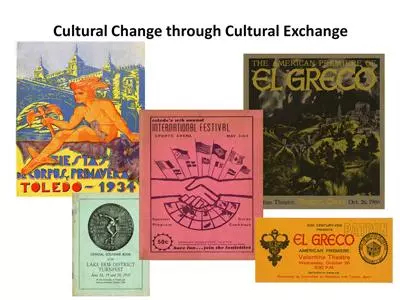 Chapter 4 - Cultural Change through Cultural Exchange
Chapter 4 - Cultural Change through Cultural Exchange
Toledo has had a long history of cultural exchange organizations that have sought to foster greater international understanding and peace. In additional to formalized relationships with cities and regions, Toledo’s immigrant populations have done much to remember their heritage through organizations that celebrate their homelands.
One of the most important cultural exchange groups is the Association of Two Toledos, the oldest sister city organization in the world. The group developed because of the natural connection of two cities with the same name, and the earliest contact between the two occurred in 1876. In 1931, UT President Henry Doermann helped to formalize the relationship when he visited the country with a small delegation. He also convinced Spain to allow the University of Toledo to model its seal after the coat of arms of Ferdinand and Isabella. While the relationship between the two cities has been disrupted at times by war, it continues today. The association also helped to influence the establishment of Toledo Sisters Cities International, which now has formal relationships with cities in Germany, Hungary, Poland, China, Pakistan, and Lebanon.
Other cultural exchange organizations focus on a particular culture. Alliance Francaise, founded by Betty Mauk, celebrates French culture and provides language classes. Toledo Turners stressed the connection between physical fitness and German culture. And many of these groups hold yearly festivals where they invite others to experience their culture, including the International Festival, an umbrella celebration of the cultures of many immigrant groups.
The University of Toledo has also played a role in cultural exchange by both opening the door to foreign students to study at UT, and also by creating opportunities for American students to study abroad.
Chapter 5 - Toledo Businesses and World Markets
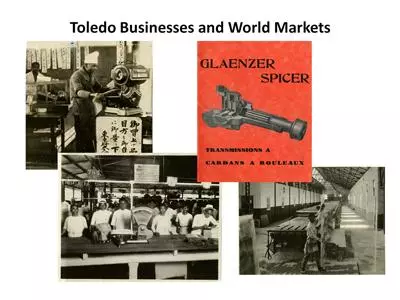 Chapter 5 - Toledo Businesses and World Markets
Chapter 5 - Toledo Businesses and World Markets
While it took time for Toledo to develop a successful industrial base, once it did, it did not take long for the companies to develop international markets.
The Owens Bottle Company, founded in 1904 by Michael Owens to produce the first machine that could produce glass bottles automatically, was one of the earliest Toledo companies to seek global expansion. One year after the company was founded, Owens and his investor Edward Drummond Libbey were selling licensing rights to the machine overseas. Within five years, the machine was in use all over Europe. Another company of Owens and Libbey—the Libbey-Owens Sheet Glass Company—sold its unique machine for making flat glass to the Japanese in 1920. The joint venture created the American-Japan Sheet Glass Company, and today is known as the huge international conglomerate of Nippon Glass.
One company that literally took the name “Toledo” around the world was Toledo Scale. Every one of its scales prominently displayed the company’s name, and the company’s motto of “No Springs, Honest Weight” was universally recognized. Some of the scales are still in use in far-flung countries around the globe today.
Another Toledo company can claim that its products played a key role in winning wars. In 1940, Willlys-Overland produced a prototype for a lightweight yet strong military vehicle that came to be known as the Jeep. During World War II, the Jeep was so key to victory that it was often called the Steel Soldier. It became a symbol to many around the world of American ingenuity.
But globalization of markets has been a double-edged sword for Toledo. Today, Toledo workers find themselves competing with workers in foreign countries were wages and regulations make products cheaper than they can be produced in the U.S.
Past exhibitions at the Ward M. Canaday Center
University of Toledo Library Catalog
University of Toledo Digital Repository
Ward M. Canaday Center for Special Collections & University Archives
Ward M. Canaday Center, Rare Book collections
Finding aids and subject links
Alliance Française of Toledo Records, 1962-1999, MSS-143
see also: Civic Interests; Education and Schools; Ethnic Culture; Social Life and Customs
Association of Two Toledos Collection, 1609-2002, MSS-071
see also: Civic Interests; Ethnic Culture; Music, Art, Drama, and Theatre; Social Life and Customs; and Travel
Leo and William Barlow Letters, 1944-1951, MSS-219
see also: War, Soldiers, and Veterans
Board of Trustees -- Minutes, 1876, UR 83/109
Mark Camp Papers, UM 97.
William S. Carlson Records, UM 14
Ward M. Canaday Collection, 1902-1991, MSS-072
see also: Business and Commerce; Civic Interests
Center for the International Studies and Programs Records, UR 99/36
Kenneth Colthorpe Papers, MSS-299
see also: Business and Commerce
Olive A. Colton Papers, 1867-1961 , MSS-008
see also: Collectors and Collecting; Social Life and Customs; Travel; Women
Dana Holding Corporation Records, 1891-2012, MSS-242
see also: Business and Commerce
Gordon M. Deye Letters, 1943-46, MSS-229
see also: War, Soldiers, and Veterans
Wilhelm J.H. Eitel Collection, UM-24
Marian G. Elfring Scrapbook, 1944-1945, MSS-231
see also: War, Soldiers, and Veterans; Women
Adam Grant Papers, 1957-2009, MSS-106
see also: Ethnic Culture; Music, Art, Drama, and Theatre
International Student Association, University of Toledo Archives, Vertical Files
Foy D. Kohler Papers, 1914-1987, MSS-036
see also: Politics and Government
Libbey-Owens-Ford Glass Company Records, 1851-1991, MSS-066
see also: Architecture; Business and Commerce; Education and Schools; Glass Industry
Betty Mauk Papers, 1969-1998, MSS-135
see also: Civic Interests; Women
Office of the President, P.C. Nash Papers, UR PA/44
Gustavus Ohlinger Papers, 1821-1987, MSS-013
see also: Civic Interests; Municipal Government; Politics and Government Politics and Government, Social Welfare, and Travel
Owens Corning Records, 1982-Present, MSS-222
see also: Business and Commerce; Glass Industry
Owens-Illinois inc. Company Records, MSS-200
see also: Business and Commerce; Glass Industry; Philanthropy
Steven Pecsenye Collection, 1944-1983, MSS-084
see also: Ethnic Culture; Music, Art, Drama, and Theatre; War, Soldiers, and Veterans
Joseph R. Scalzo Papers, 1944-1986, MSS-083
see also: Business and Commerce
Max T. Schnitker Papers,1936-1983, MSS-142
see also: Medicine and Health; War, Soldiers, and Veterans
Ella P. Stewart Papers, MSS-052, 1922-1987
see also: African-Americans; Civic Interests; Medicine & Health; Social Welfare; Women
Toledo China-Burma-India Veterans Association Records, 1945-2005, MSS-209
see also: War, Soldiers, and Veterans
Toledo City Council Records, 1837-1952, MSS 297
Toledo Scale Collection, 1900-1980, MSS-153
see also: Business and Commerce
Toledo Sister Cities International, 1993-2003, MSS-203
see also: Civic Interests; Ethnic Culture
Toledo Turners Collection, 1858-1987, MSS-103
see also: Ethnic Culture; Social Life and Customs
Toledo United Nations Association, Executive Records, UR PA/84
United Spanish War Veterans, Egbert Camp No. 10 (Toledo) Records, 1901-1972, MSS-028
see also: War, Soldiers, and Veterans
James Van Orden Collection, 1886-2005, MSS-290
see also: Business and Commerce
Herbert M. White Papers, 1916-1974, MSS-096
see also: War, Soldiers, and Veterans
Brand Whitlock Letters, 1915, MSS-023
see also: Politics and Government; Social Welfare
John W. Yager Association of Two Toledos, 1958-1971, MSS-120
see also: Civic Interests; Music, Art, Drama, and Theatre; Travel
Oher regional resources
Toledo's Attic Resources
Toledo Sister City Digital Heritage: A Virtual Exhibition
Virtual Exhibition - Greater Toledo: The City in the World (Credits)
Sara Mouch, assistant archivist/curator (review, feedback, exhibition layout map)
Arjun Sabharwal, digital initiative librarian (site design, photography, scanning)
Emily Schoenlein, digital initiatives assistant (scanning, descriptions)
Lauren White, manuscripts librarian (review, feedback, description)
Catalog Contributors
Barbara Floyd, university archivist & director, Ward M. Canaday Center for Special Collections
Tamara Jones, librarian
Sara Mouch, curator and assistant/university archivist
Brandy Raymer, undergraduate intern from the Department of History
Arjun Sabharwal, digital initiative librarian (virtual exhibition also)
Mark Troknya, volunteer (Toledo Museum of Art); and
Lauren White, manuscripts librarian.

